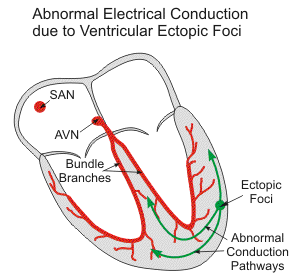Ectopic Foci
Ectopic foci are abnormal pacemaker sites within the heart (outside the SA node) that display automaticity. Their pacemaker activity, however, is normally suppressed (overdrive suppression) by the higher rate of the SA node. They can occur within the atria or ventricles.
 Ectopic foci can cause additional beats (observed as premature beats) or take over the normal pacemaker activity of the SA node. These ectopic pacemakers can lead to either tachycardia or bradycardia, depending upon their location and surrounding electrical conditions. For example, ectopic foci in the ventricle, when coupled with a reentry pathway, can precipitate ventricular tachycardia. In third degree AV nodal block, a ventricular rhythm still occurs because normally latent ectopic pacemaker sites within the ventricle are no longer suppressed. These ectopic ventricular pacemakers produce a rhythm (30-40 beats/minutes); this resting rate is much slower than that produced by the SA node (60-100 beats/min).
Ectopic foci can cause additional beats (observed as premature beats) or take over the normal pacemaker activity of the SA node. These ectopic pacemakers can lead to either tachycardia or bradycardia, depending upon their location and surrounding electrical conditions. For example, ectopic foci in the ventricle, when coupled with a reentry pathway, can precipitate ventricular tachycardia. In third degree AV nodal block, a ventricular rhythm still occurs because normally latent ectopic pacemaker sites within the ventricle are no longer suppressed. These ectopic ventricular pacemakers produce a rhythm (30-40 beats/minutes); this resting rate is much slower than that produced by the SA node (60-100 beats/min).
When ectopic foci drive the rhythm of the heart, the spread of depolarization rarely follows the normal, fast conducting pathways within the heart. Because of this, the depolarization wave takes longer to spread throughout the myocardium. This typically causes a shape change in the QRS complex and prolongs its duration (>0.10 sec) because more time is required for the entire ventricle to become depolarized.
Revised 11/02/2023

 Cardiovascular Physiology Concepts, 3rd edition textbook, Published by Wolters Kluwer (2021)
Cardiovascular Physiology Concepts, 3rd edition textbook, Published by Wolters Kluwer (2021) Normal and Abnormal Blood Pressure, published by Richard E. Klabunde (2013)
Normal and Abnormal Blood Pressure, published by Richard E. Klabunde (2013)